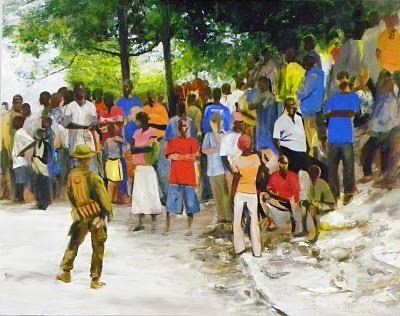American official war artists have been part of the American military since 1917. Artists are unlike the objective camera lens which records only a single instant and no more. The war artist captures instantaneous action and conflates earlier moments of the same scene within one compelling image.
In World War I, eight artists commissioned as captains in the U.S. Corps of Engineers. These men were sent to Europe to record the activities of the American Expeditionary Forces.
In 1941, the Navy Combat Art Program was founded in order to ensure that competent artists would be present at the scene of history-making events. Eight active duty artists developed a record of all phases of World War II; and all major naval operations have been depicted by Navy artists. During the Korean War, the program was revived with two military artists in combat contexts. Since then, artists have been sent to other combat zones, including the Persian Gulf.
The U.S. Army War Art Unit was established in late 1942; and by the spring of 1943, 42 artists were selected. In May 1943, Congress withdrew funding the unit was inactivated.
The Army's Vietnam Combat Art Program was started in 1966. Teams of soldier-artists created pictorial accounts and interpretations for the annals of army military history. These teams of five soldier-artists typically spent 60 days of temporary duty (TDY) in Vietnam embedded with various units. The U. S. Army Center of Military History (CMH) currently includes an Army Art Collection with about 40 representative war artists.
In 1992, the Army Staff Artist Program was attached to the United States Army Center of Military History. Army artists are a permanent part of the Museum Division's Collections Branch.
There are significant differences in the artwork created by the branches of the U.S. military:
Military art and the work of American military artists includes both peacetime and wartime. For example, USMC combat artist Kristopher Battles deployed with American forces in Haiti to provide humanitarian relief as part of Operation Unified Response after the disastrous earthquake in 2010.
William James AylwardWalter Jack DuncanHarvey Thomas DunnKerr Eby MarinesGeorge Matthews HardingWallace MorganErnest Clifford PeixottoJohn Singer SargentJ. Andre Smith.Harry Everett Townsend, Army.Claggett Wilson ArmySidney Simon, 1917-1997 Standish Backus, 1910–1989McClelland Barclay, 1891–1942 George Biddle, 1885–1973Franklin Boggs, 1914-2009Aaron Bohrod, 1907–1992 Howard Brodie, 1915–2010 Manuel Bromberg, 1917–Jack Coggins, 1914–2006 John Steuart Curry 1897–1946, for information about his war art, see his artwork pageOlin Dows, 1904–1981 Edward Dugmore, 1915–1996 William Franklin Draper, 1912–2003 Nathan Glick, 1912–Mitchel Jamieson, 1915–1976Joe Jones, 1909–1963 Yasuo Kuniyoshi, 1893–1953Ludwig Mactarian (1908 – 1955)John McDermott, 1919–1977 John Cullen Murphy, 1919–2004 Albert K. Murray, 1906–1992Henry Varnum Poor, 1887–1970Dwight Shepler, 1905–1974Mitchell Siporin, 1910–1976Taro YashimaCAT I, 15 Aug - 15 Dec 1966, Roger A. Blum (Stillwell, KS), Robert C. Knight (Newark, NJ), Ronald E. Pepin (East Hartford, CT), Paul Rickert (Philadelphia, PA), Felix R. Sanchez (Fort Madison, IA), John O. Wehrle (Dallas, TX), and supervisor, Frank M. Sherman.CAT II, 15 Oct 1966 - 15 Feb 1967, Augustine G. Acuna (Monterey, CA), Alexander A. Bogdanovich (Chicago, IL), Theodore E. Drendel (Naperville, IL), David M. Lavender (Houston, TX), Gary W. Porter (El Cajon, CA), and supervisor, Carolyn M. O'Brien.CAT III, 16 Feb - 17 June 1967, Michael R. Crook (Sierra Madre, CA), Dennis O. McGee (Castro Valley, CA), Robert T. Myers (White Sands Missile Range, NM), Kenneth J. Scowcroft (Manassas, VA), Stephen H. Sheldon (Los Angeles, CA), and supervisor, C. Bruce Smyser.CAT IV, 15 Aug - 31 Dec 1967, Samuel E. Alexander (Philadelphia, MS), Daniel T. Lopez (Fresno, CA), Burdell Moody (Mesa, AZ), James R. Pollock (Pollock, SD), Ronald A. Wilson (Alhambra, CA), and technical supervisor, Frank M. Thomas.CAT V, 1 Nov 1967 - 15 March 1968, Warren W. Buchanan (Kansas City, MO), Philip V. Garner (Dearborn, MI), Phillip W. Jones (Greensboro, NC), Don R. Schol (Denton, TX), John R. Strong (Kanehoe, HI), and technical supervisor, Frank M. Thomas.CAT VI, 1 Feb - 15 June 1968, Robert T. Coleman (Grand Rapids, MI), David N. Fairrington (Oakland, CA), John D. Kurtz IV (Wilmington, DE), Kenneth T. McDaniel (Paris, TN), Michael P. Pala (Bridgeport, CT).CAT VII, 15 Aug - 31 Dec 1968, Brian H. Clark (Huntington, NY), William E. Flaherty Jr. (Louisville, KY), William C. Harrington (Terre Haute, IN), Barry W. Johnston (Huntsville, AL), Stephen H. Randall (Des Moines, IA), and supervisor, Fitzallen N. Yow.CAT VIII, 1 Feb - 15 June 1969, Edward J. Bowen (Carona Del Mar, CA), James R. Drake (Colorado Springs, CO), Roman Rakowsky (Cleveland, OH), Victory V. Reynolds (Idaho Falls, ID), Thomas B. Schubert (Chicago, IL), and supervisor, Fred B. Engel.CAT IX, 1 Sept 1969 - 14 Jan 1970, David E. Graves (Lawrence, KS), James S. Hardy (Coronado, CA), William R. Hoettels (San Antonio, TX), Bruce N. Rigby (Dekalb, IL), Craig L. Stewart (Laurel, MD), and supervisor, Edward C. Williams.Kristopher BattlesHenry CasselliMichael D. Fay
